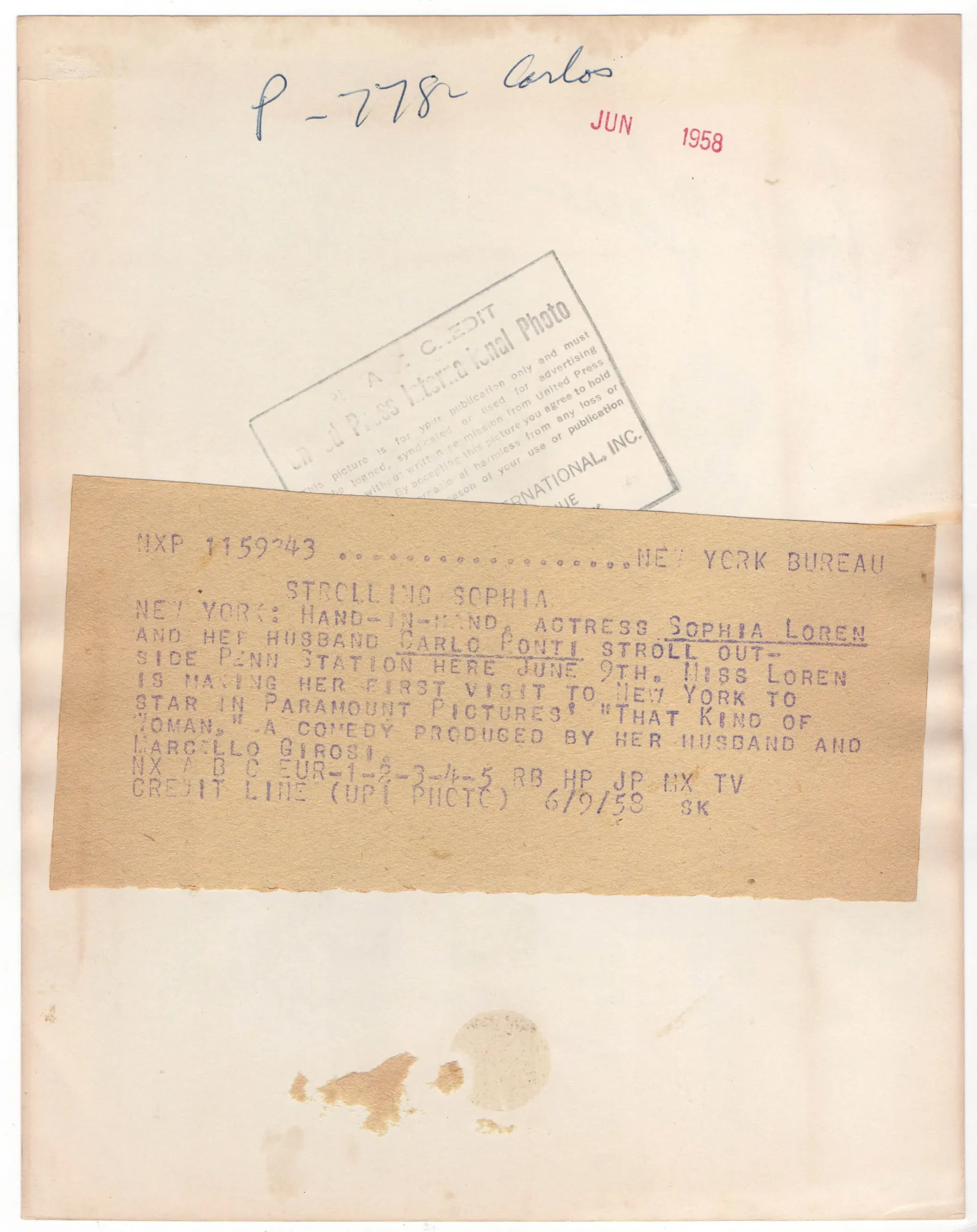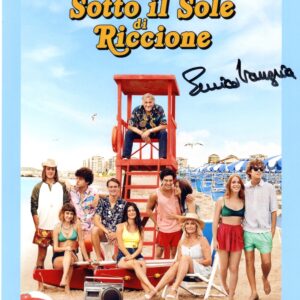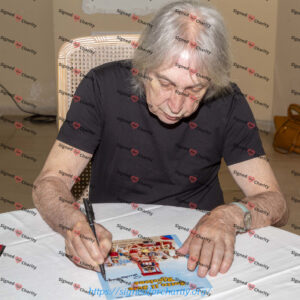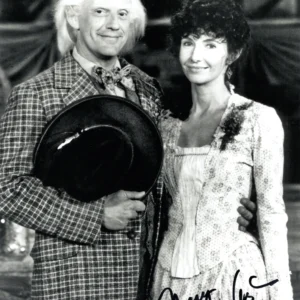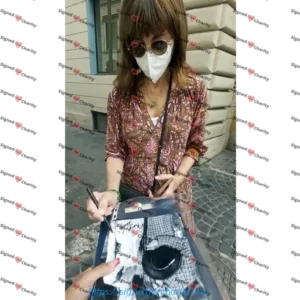Description
SOPHIA LOREN BIOGRAPHY :
Sofia Villani Scicolone Dame Grand Cross OMRI (born 20 September 1934), known professionally as Sophia Loren is an Italian actress. She was named by the American Film Institute as the 21st greatest female star of Classic Hollywood Cinema. Encouraged to enroll in acting lessons after entering a beauty pageant, Loren began her film career at age 16 in 1950. She appeared in several bit parts and minor roles in the early part of the decade, until her five-picture contract with Paramount in 1956 launched her international career. Her film appearances around this time include The Pride and the Passion, Houseboat, and It Started in Naples. Loren’s performance as Cesira in the movie Two Women (1961) directed by Vittorio De Sica earned her the Academy Award for Best Actress, making her the first actor or actress to win an Oscar for a foreign-language performance. She holds the record for having earned six David di Donatello Awards for Best Actress: Two Women; Yesterday, Today and Tomorrow (1963); Marriage Italian Style (1964, for which she was nominated for a second Oscar); Sunflower (1970); The Voyage (1974); and A Special Day (1977). After starting a family in the early 1970s, Loren chose to make rarer film appearances. Since then, she has appeared in American films such as Grumpier Old Men (1995) and Nine (2009). She has won a Grammy Award, five special Golden Globes (including the Cecil B. DeMille Award), a BAFTA Award, a Laurel Award, the Volpi Cup for Best Actress at the Venice Film Festival and the Best Actress Award at the Cannes Film Festival. In 1991, she received the Academy Honorary Award for lifetime achievements.
Early life
Sofia Villani Scicolone was born on 20 September 1934 in the Clinica Regina Margherita in Rome, Italy, the daughter of Romilda Villani (1910–1991) and Riccardo Scicolone, a construction engineer of noble descent (Loren wrote in her autobiography that she is entitled to call herself the Marchioness of Licata Scicolone Murillo). Loren’s father, Riccardo Scicolone, refused to marry Villani, leaving the piano teacher and aspiring actress without financial support. Loren met with her father three times, at age five, age seventeen and in 1976 at his deathbed, citing that she forgave him but had never forgotten his abandonment of her mother. Loren’s parents had another child together, her sister Maria, in 1938. Loren has two younger paternal half-brothers, Giuliano and Giuseppe. Romilda, Sofia, and Maria lived with Loren’s grandmother in Pozzuoli, near Naples. During the Second World War, the harbour and munitions plant in Pozzuoli was a frequent bombing target of the Allies. During one raid, as Loren ran to the shelter, she was struck by shrapnel and wounded in the chin. After that, the family moved to Naples, where they were taken in by distant relatives. After the war, Loren and her family returned to Pozzuoli. Loren’s grandmother Luisa opened a pub in their living room, selling homemade cherry liquor. Romilda Villani played the piano, Maria sang, and Loren waited on tables and washed dishes. The place was popular with the American GIs stationed nearby.
Pageantry
At age 15, Loren as Sofia Lazzaro entered the Miss Italia 1950 beauty pageant and was assigned as Candidate #2, being one of the four contestants representing the Lazio region. She was selected as one of the last three finalists and won the title of “Miss Elegance 1950”, while Liliana Cardinale won the title of “Miss Cinema” and Anna Maria Bugliari won the grand title of Miss Italia. She returned in 2001 as president of the jury for the 61st edition of the pageant. In 2010, Loren crowned the 71st Miss Italia pageant winner.
In film
1951–1953: as Sofia Scicolone, and as Sofia Lazzaro
Sofia Lazzaro enrolled in the Centro Sperimentale di Cinematografia, the national film school of Italy and appeared as an uncredited extra in Mervyn LeRoy’s 1951 film Quo Vadis, when she was 16 years old. That same year, she appeared in the Italian film Era lui… sì! sì!, in which she played an odalisque, and was credited as Sofia Lazzaro. In the early part of the decade, she played bit parts and had minor roles in several films, including La Favorita (1952).
1953–1970: as Sophia Loren
Carlo Ponti changed her name and public image to appeal to a wider audience as Sophia Loren, being a twist on the name of the Swedish actress Märta Torén and suggested by Goffredo Lombardo. Her first starring role was in Aida (1953), for which she received critical acclaim. After playing the lead role in Two Nights with Cleopatra (1953), her breakthrough role was in The Gold of Naples (1954), directed by Vittorio De Sica. Too Bad She’s Bad, also released in 1954, and La Bella Mugnaia (1955) became the first of many films in which Loren co-starred with Marcello Mastroianni. Over the next three years, she acted in many films, including Scandal in Sorrento, Lucky to Be a Woman, Boy on a Dolphin, Legend of the Lost and The Pride and the Passion.
International fame
Loren became an international film star following her five-picture contract with Paramount Pictures in 1958. Among her films at this time were Desire Under the Elms with Anthony Perkins, based upon the Eugene O’Neill play; Houseboat, a romantic comedy co-starring Cary Grant; and George Cukor’s Heller in Pink Tights, in which she appeared as a blonde for the first time. In 1960, she starred in Vittorio De Sica’s Two Women, a stark, gritty story of a mother who is trying to protect her 12-year-old daughter in war-torn Italy. The two end up gang-raped inside a church as they travel back to their home city following cessation of bombings there. Originally cast as the daughter, Loren fought against type and was eventually cast as the mother (actress Eleonora Brown would portray the daughter). Loren’s performance earned her many awards, including the Cannes Film Festival’s best performance prize, and an Academy Award for Best Actress, the first major Academy Award for a non-English-language performance or to an Italian actress. She won 22 international awards for Two Women. The film was extremely well received by critics and a huge commercial success. Though proud of this accomplishment, Loren did not show up to this award, citing fear of fainting at the award ceremony. Nevertheless, Cary Grant telephoned her in Rome the next day to inform her of the Oscar award. During the 1960s, Loren was one of the most popular actresses in the world, and continued to make films in the United States and Europe, starring with prominent leading men. In 1964, her career reached its pinnacle when she received $1 million to appear in The Fall of the Roman Empire. In 1965, she received a second Academy Award nomination for her performance in Marriage Italian-Style. Among Loren’s best-known films of this period are Samuel Bronston’s epic production of El Cid (1961) with Charlton Heston, The Millionairess (1960) with Peter Sellers, It Started in Naples (1960) with Clark Gable, Vittorio De Sica’s triptych Yesterday, Today and Tomorrow (1963) with Marcello Mastroianni, Peter Ustinov’s Lady L (1965) with Paul Newman, the 1966 classic Arabesque with Gregory Peck, and Charlie Chaplin’s final film, A Countess from Hong Kong (1967) with Marlon Brando. Loren received four Golden Globe Awards between 1964 and 1977 as “World Film Favorite – Female”.
1970–1988: Continued success
Loren appeared in fewer movies after becoming a mother. During the next decade, most of her roles were in Italian features. During the 1970s, she was paired with Richard Burton in the last De Sica-directed film, The Voyage (1974), and a remake of the film Brief Encounter (1974). The film had its premiere on US television on 12 November 1974 as part of the Hallmark Hall of Fame series on NBC. In 1976, she starred in The Cassandra Crossing. It fared extremely well internationally, and was a respectable box office success in US market. She co-starred with Marcello Mastroianni in Ettore Scola’s A Special Day (1977). This movie was nominated for 11 international awards such as two Oscars (best actor in leading role, best foreign picture). It won a Golden Globe Award and a César Award for best foreign movie. Loren’s performance was awarded with a David di Donatello Award, the seventh in her career. The movie was extremely well received by American reviewers and became a box office hit. Following this success, Loren starred in an American thriller Brass Target. This movie received mixed reviews, although it was moderately successful in the United States and internationally. In 1978, she won her fourth Golden Globe for “world film favorite”. Other movies of this decade were Academy award nominee Sunflower (1970), which was a critical success, and Arthur Hiller’s Man of La Mancha (1972), which was a critical and commercial failure despite being nominated for several awards, including two Golden Globes. O’Toole and James Coco were nominated for two NBR awards, in addition the NBR listed Man of La Mancha in its best ten pictures of 1972 list.In 1980, after the international success of the biography Sophia Loren: Living and Loving, Her Own Story by A. Hotchner, Loren portrayed herself and her mother in a made-for-television biopic adaptation of her autobiography, Sophia Loren: Her Own Story. Ritza Brown and Chiara Ferrari each portrayed the younger Loren. In 1981, she became the first female celebrity to launch her own perfume, ‘Sophia’, and a brand of eyewear soon followed. In 1982, while in Italy, she made headlines after serving an 18-day prison sentence on tax evasion charges – a fact that failed to hamper her popularity or career. In 2013, the supreme court of Italy cleared her of the charges. She acted infrequently during the 1980s and in 1981 turned down the role of Alexis Carrington in the television series Dynasty. Although she was set to star in 13 episodes of CBS’s Falcon Crest in 1984 as Angela Channing’s half-sister Francesca Gioberti, negotiations fell through at the last moment and the role went to Gina Lollobrigida instead. Loren preferred devoting more time to raising her sons. Loren has recorded more than two dozen songs throughout her career, including a best-selling album of comedic songs with Peter Sellers; reportedly, she had to fend off his romantic advances. Partly owing to Sellers’s infatuation with Loren, he split with his first wife, Anne Howe. Loren has made it clear to numerous biographers that Sellers’s affections were reciprocated only platonically. This collaboration was covered in The Life and Death of Peter Sellers where actress Sonia Aquino portrayed Loren. The song “Where Do You Go To (My Lovely)?” by Peter Sarstedt was said to have been inspired by Loren.
Later career
In 1991, Loren received the Academy Honorary Award for her contributions to world cinema and was declared “one of the world cinema’s treasures”. In 1995, she received the Golden Globe Cecil B. DeMille Award. She presented Federico Fellini with his honorary Oscar in April 1993. In 2009, Loren stated on Larry King Live that Fellini had planned to direct her in a film shortly before his death in 1993. Throughout the 1990s and 2000s, Loren was selective about choosing her films and ventured into various areas of business, including cookbooks, eyewear, jewelry, and perfume. She received a Golden Globe nomination for her performance in Robert Altman’s film Ready to Wear (1994), co-starring Julia Roberts. In 1994, a Golden Palm Star on the Palm Springs, California, Walk of Stars was dedicated to her. In Grumpier Old Men (1995), Loren played a femme fatale opposite Walter Matthau, Jack Lemmon, and Ann-Margret. The film was a box-office success and became Loren’s biggest US hit in years. At the 20th Moscow International Film Festival in 1997, she was awarded an Honorable Prize for contribution to cinema. In 1999, the American Film Institute named Loren among the greatest female stars of Golden Age of Hollywood cinema. In 2001, Loren received a Special Grand Prix of the Americas Award at the Montreal World Film Festival for her body of work. She filmed two projects in Canada during this time: the independent film Between Strangers (2002), directed by her son Edoardo and co-starring Mira Sorvino, and the television miniseries Lives of the Saints (2004). In 2009, after five years off the set and 14 years since she starred in a prominent US theatrical film, Loren starred in Rob Marshall’s film version of Nine, based on the Broadway musical that tells the story of a director whose midlife crisis causes him to struggle to complete his latest film; he is forced to balance the influences of numerous formative women in his life, including his deceased mother. Loren was Marshall’s first and only choice for the role. The film also stars Daniel Day-Lewis, Penélope Cruz, Kate Hudson, Marion Cotillard, and Nicole Kidman. As a part of the cast, she received her first nomination for a Screen Actors Guild Award. In 2010, Loren played her own mother in a two-part Italian television miniseries about her early life, directed by Vittorio Sindoni with Margareth Madè as Loren, entitled La Mia Casa È Piena di Specchi (My House Is Full of Mirrors), based on the memoir by her sister Maria. In July 2013 Loren made her film comeback in an Italian short-film adaptation of Jean Cocteau’s 1930 play The Human Voice (La Voce Umana), which charts the breakdown of a woman who is left by her lover – with her younger son, Edoardo Ponti, as director. Filming took under a month during July in various locations in Italy, including Rome and Naples. It was Loren’s first theatrical film since Nine. She returned to feature-length film in Ponti’s 2020 feature film, The Life Ahead.


